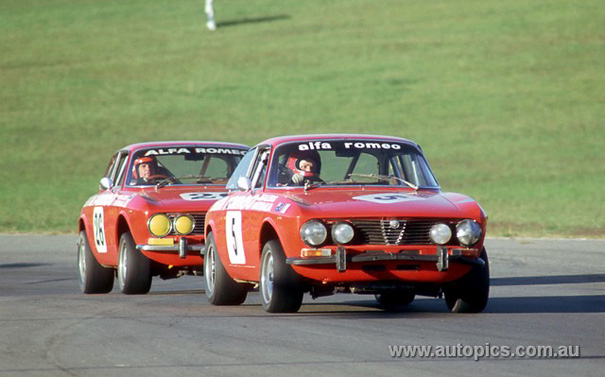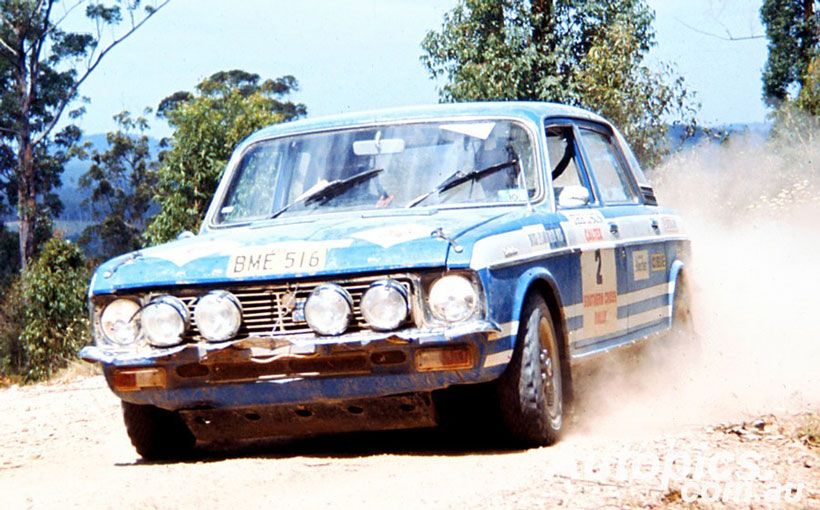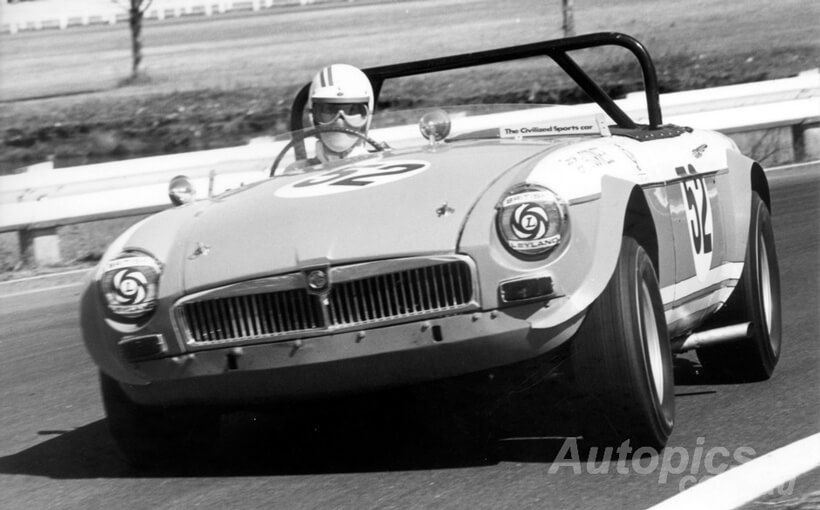The Mum-to-be and the Alfa that almost stole the 1975 ATCC

After five rounds of the 1975 Australian Touring Car Championship, Christine Gibson was only three points behind series leader Allan Grice and two ahead of Colin Bond with two rounds remaining.
On the face of it, that was already a huge achievement for the respected 28-year-old female racer in such a male-dominated sport.
What made it all the more astounding was that Grice and Bond were driving V8-powered Torana L34s while ‘Mrs Gibson’ was in a four cylinder Alfa Romeo 2000 GTV.
And she was also about five months’ pregnant at the time!
Christine’s relentless rise to second place in the ATCC points standings had been the result of outstanding speed and consistency in the factory-backed 105-series Italian coupe and mixed fortunes for the outright contenders in their brutish Toranas.
Gibson missed the opening round before scoring four straight wins in the 2.0 litre class. In stark contrast, competition amongst the faster Holden V8s in the outright division had resulted in several different winners, with their points haul more evenly shared.
Of critical importance to Gibson’s chance of toppling the Toranas was an incident that occurred after the fifth round at Surfers Paradise. Race winner Allan Grice was disqualified after post-race scrutineering revealed his Torana V8 had raced without its engine cooling thermostat fitted.
Grice immediately appealed but his disqualification meant that he lost the 13 points earned for winning the race. And history shows that any points he earned in the remaining two rounds were also disallowed after his various appeals were dismissed.
So, in reality, Gibson went into the ‘cliff-hanger’ penultimate round at Adelaide International Raceway with a slender two-point lead over Colin Bond’s HDT Torana.
The petite racer stood a real chance of making history by becoming the first female to win the ATCC. And if she did, a small importer like Alfa Romeo would seriously embarrass The General and its Torana V8 by becoming the first under 2.0 litre car to win the title outright.
Why she failed to pull it off, after a disastrous round in Adelaide, is a fascinating tale.

Alfa Romeo gets serious
Alfa Romeo’s credentials were already well established in Australian motor sport and dealer showrooms when the company announced the formation of a genuine factory team at a Sydney launch held at Brian Foley’s Alfa Romeo dealership at Parramatta in May 1975.
Foley and his Sydney-based dealer/racer counterpart Alec Mildren had been doing stellar work in the late 1960s and early ‘70s creating a halo of sophistication and excitement around the brand through motor racing successes.
Foley not only sold and serviced the Italian cars but was also a talented race driver who consistently enjoyed many giant-killing performances in a variety of 105 series race cars.
Mildren, too, had proven to be a stalwart for the brand as a car dealer and race team owner in the same era, employing top-line talent like Frank Gardner and Kevin Bartlett to drive a variety of Alfa-powered open wheeler racing cars and 105 series sedans and coupes with considerable success.
However, it wasn’t until 1975, after Alfa Romeo had set up a permanent Australian head office at Botany in Sydney, that the Italian marque was ready to present a unified factory presence in motor sport with the formation of the Alfa Romeo Dealers Australia team.
Such a move was designed to not only ensure the brand’s continued motor sport success but create a more streamlined and cohesive marketing strategy, to squeeze maximum promotional value out of racing achievements to boost showroom traffic in the dealer network.
Brian Foley, who had recently retired from race driving, was appointed team manager of the new factory-backed operation which was in effect a rebranding of his existing race team. Foley also owned the 2000 GTV that Christine Gibson would drive, with the other owned and raced by prominent Queensland Alfa dealer and racing veteran John French.
By 1975 Christine Gibson was already an experienced and respected competitor, having started racing Minis in the mid-1960s, under her maiden name Christine Cole. She also drove a Torana GTR XU-1 for HDT in the Bathurst 500 and competed in rallying and rallycross before starting her association with Foley in 1973 driving the Alfa 2000 GTV.
This produced some impressive results, including her emphatic 2.0 litre class win at the 1973 Manufacturers Championship race at Surfers Paradise where she finished fourth outright behind three Torana XU-1s.
For 1975 the two Alfa works cars were prepared initially by Christine’s husband Fred Gibson. In addition to his numerous racing achievements as a Ford works driver and Bathurst 500 winner, Gibson also ran a successful high performance tuning shop in Sydney called ‘Road & Track’.
Later in the season, when the workload of looking after the two Alfas in addition to Gibson’s other clients’ cars at R&T became unmanageable, the Alfas were moved to a new workshop established at Alfa’s head office under chief mechanic Peter Glover.
The new works team was funded locally by Alfa Romeo dealers, with additional backing from Singapore Airlines, Shell (fuels/oils), Bridgestone (tyres) and La Fiamma which was Australia’s biggest foreign language newspaper at the time
The 1975 program was to include the seven-round ATCC and five-round Australian Manufacturer’s Championship.

So close to standard
Touring car racing under Australia’s home-grown Production Touring (Group C) rules was much simpler than today, with such a tight limit on modifications permitted for competition use that they were in reality little more than hotted-up road cars.
A track test conducted by Sports Car World magazine in 1975 highlighted how close Christine Gibson’s 2000 GTV factory racer was to the standard showroom product.
The SCW story revealed that Gibson’s car, although looking brand new, was actually three years old by then and had covered close to 7000 racing miles (11,000 kms) in Gibson’s hands, among others.
Photos revealed the car’s basic bolt-in roll cage made from lightweight aluminium tubing, six-point racing harness, smaller diameter Autodelta sports steering wheel with classy Alfa Romeo centre cap, large oil pressure gauge mounted on top of the dashboard (where Chris could see it best) and a fire extinguisher.
Apart from those minor alterations, the interior remained stock standard right down to the gearstick for the five-speed ‘box, bucket seats and floor carpets.
Under the bonnet the Alfa’s showroom heritage was just as authentic, with a tidy engine bay containing the potent 2.0 litre DOHC aluminium four cylinder engine with two large 45mm DCOE side-draught Weber carbs mounted on the right-hand side. The raucous open exhaust system exited under the passenger door sill.
According to SCW’s figures, Australia’s fastest 2.0 litre tourer was good for 115 kW (about 155 bhp) at 6600rpm, which was about 800 rpm further around the tacho face than the standard engine.
Christine Gibson said that she was using a self-imposed redline of 7200rpm at the time, but revealed that her team-mate French was regularly exceeding 8000 rpm in his car!
Fred Gibson told Shannons Club that with ongoing development they ended up squeezing about 170 bhp out of these engines, which was the most power you could expect given the rule restrictions that existed at the time.
The standard suspension was uprated with stiffer coil springs, anti-roll bars and adjustable shocks.
The team also experimented with different wheel combinations to take full advantage of the extra tyre width allowed under the rules, comprising a mix of Italian Campagnolo and locally-made Rennmax four-spoke magnesium racing wheels.
And as you will discover, it was the need to accommodate these larger wheels and tyres that brought the Alfa attack undone at a critical stage in the championship.

1975 ATCC: So close, yet so far
The new Alfa Romeo Dealers Australia team was a no-show for the opening round at Tasmania’s Symmons Plains Raceway due to unforeseen delays.
However, the two-car team was out in force for the second round held at Melbourne’s Calder Park, where privateer Allan Grice left no one in any doubt he was launching a serious bid for the national crown with a convincing win in his Craven Mild Torana.
Christine Gibson created the same impression with a clean and disciplined drive to win the 2.0 litre class ahead of arch rival Bob Holden in his Ford Escort Twin Cam and team-mate French in third.
The Alfa driver continued her impressive race-winning form in the third round at Sydney’s Amaroo Park, where she showed she could play just as rough as the boys.
Gibson’s Alfa and Holden’s Escort got very physical in two fender-bending clashes during the race, with the Ford driver coming off second best in the latter altercation as Gibson raced away to another class win.
And, in stark contrast to her on-track persona, it was also at that Amaroo Park round that the first signs emerged she was in the early stages of pregnancy with the couple’s first child.
“She fainted that day!” Fred Gibson says. “I was walking back to our pit with some new tyres for the cars and this guy runs up and tells me that my wife had just fainted in the dummy grid area, so I just dropped everything and went to find her.
“When I got there she was still sitting on the ground. Christine’s always had low blood pressure so when I got there she said ‘I’m okay, I’ll be right in a minute’ thinking it was just something to do with her blood pressure. The doctor gave her a check-up and said she was okay to race, so she did.”
Christine told Shannons Club that when she fainted again at work a few weeks later, a visit to her doctor confirmed that she was indeed a mum-to-be.
“I don’t remember what the FIA rules were at the time about how long a pregnant woman could race for but CAMS was okay with it,” Christine said. “I felt pretty right after that (early fainting spells) and wanted to keep driving until the end of the championship to try and win it.”
Christine and the Alfa team repeated the dose at Oran Park’s round four, racing to another convincing class win ahead of team-mate French who was now driving to team tactics to ensure Gibson continued to pile on the points.
She did it again in the round five at Queensland’s Surfers Paradise Raceway, claiming maximum class points for the fourth round in succession. Then race winner Grice’s post-race disqualification and loss of points instantly changed the whole equation.

So the championship battle moved to Adelaide International Raceway for the penultimate round, with Gibson and her little Alfa three points behind series leader Grice and two points ahead of Bond’s HDT Torana – but from there it all went pear-shaped.
With Bond leading the 35-lap race outright, French was in front of the 2.0 litre battle and under team orders poised to allow his team-mate to pass him before the chequered flag. However, a miscalculation by the Alfa team of the number of laps remaining meant that despite French’s last-minute efforts to stop in time, he crossed the finish line in front of Gibson!
And it got worse during post-race scrutineering, when both of the works Alfas were disqualified and all points lost for having top links in the front suspension and inner rear wheel housings that did not comply with the rules.
Bob Holden was awarded the round win in his Ford Escort and went on to wrap-up the 2.0 litre title at Lakeside’s final round.
“I wasn’t involved with the team when they first built those cars,” Fred Gibson revealed. “They were put together by one of Foley’s guys, so I wasn’t across everything he had done to them when I took over the prep and that’s always a risk you face.
“Obviously they wanted to run the widest tyres that they could under the rules, so to make those big (Rennmax) wheels fit within the standard bodywork they had to run a lot of the rim offset to the inside rather than the outside.
“That obviously presented some clearance problems, but what I didn’t realise was that he’d just gone and modified the front suspension arms and rear wheel housings to make them fit without telling anyone!”

The double-whammy in Alfa’s Adelaide debacle was that Christine Gibson and John French were also banned from racing for three months, so her potential history-making title attempt was finished.
The timing of the scrutineering bust certainly raised some eyebrows, given that a small Italian importer was poised to make life unbearable for Australia’s No.1 car maker and its Torana V8.
There were rumours that the scrutineers had been tipped off about the cars and knew exactly where to look, to eliminate any mathematical chance of Alfa Romeo making GM-H a laughing stock at the final round.
Not that any of these pit lane rumours were proven of course, but it certainly added to the intrigue surrounding the 1975 ATCC.
For Christine Gibson, her disqualification and three-month suspension was a bitter pill to swallow having come so close to a championship showdown with the HDT. Even so, the time had come to quit driving anyway, to concentrate on the healthy birth of the first of her and Fred’s two daughters.









